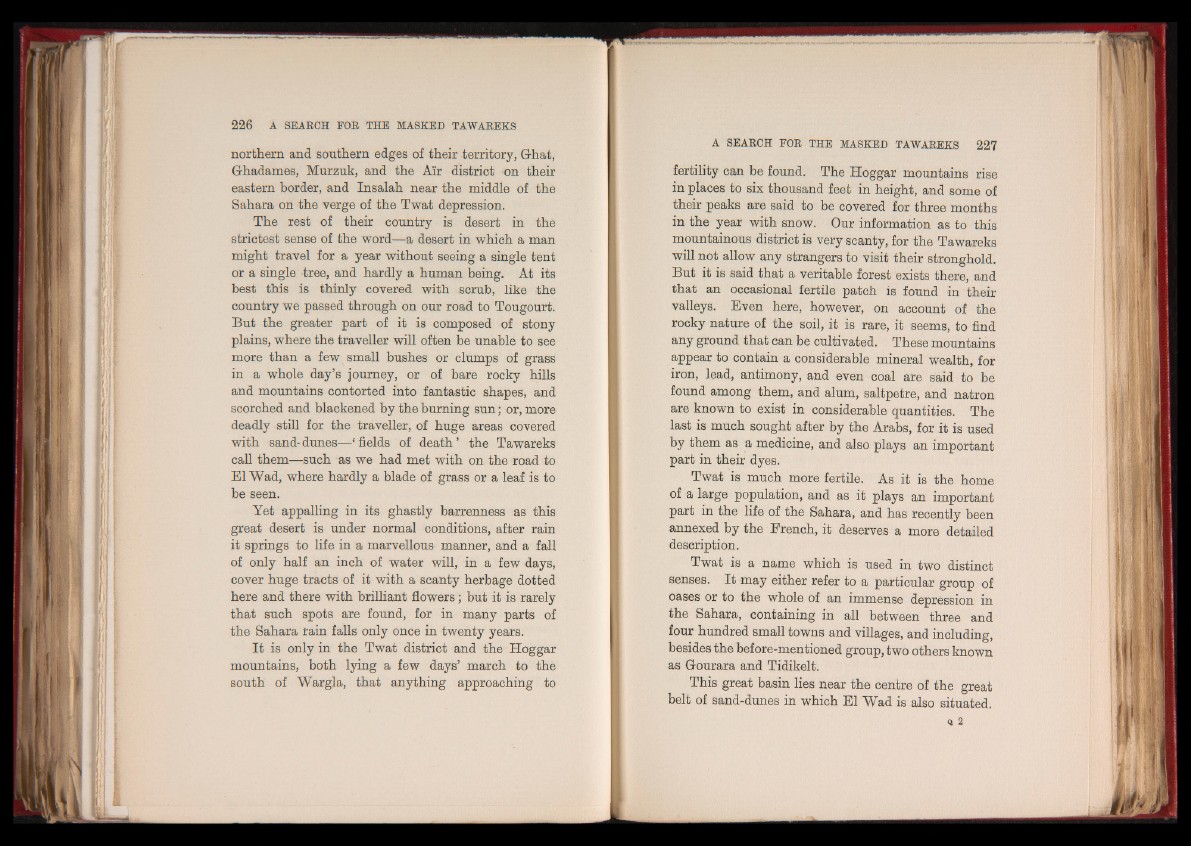
northern and southern edges of their territory, Ghat,
Ghadames, Murzuk, and the Air district on their
eastern border, and Insalah near the middle of the
Sahara on the verge of the Twat depression.
The rest of their country is desert in the
strictest sense of the word—a desert in which a man
might travel for a year without seeing a single tent
or a single tree, and hardly a human being. At its
best this is thinly covered with scrub, like the
country we passed through on our road to Tougourt.
But the greater part of it is composed of stony
plains, where the traveller will often be unable to see
more than a few small bushes or clumps of grass
in a whole day’s journey, or of bare rocky hills
and mountains contorted into fantastic shapes, and
scorched and blackened by the burning sun; or, more
deadly still for the traveller, of huge areas covered
with sand-dunes—‘fields of death’ the Tawareks
call them—such as we had met with on the road to
El Wad, where hardly a blade of grass or a leaf is to
be seen.
Yet appalling in its ghastly barrenness as this
great desert is under normal conditions, after rain
it springs to life in a marvellous- manner, and a fall
of only half an inch of water will, in a few days,
cover huge tracts of it with a scanty herbage dotted
here and there with brilliant flowers; but it is rarely
that such spots are found, for in many parts of
the Sahara rain falls only once in twenty years.
It is only in the Twat district and the Hoggar
mountains, both lying a few days’ march to the
south of Wargla, that anything approaching to
fertility can be found. The Hoggar mountains rise
in places to six thousand feet in height, and some of
their peaks are said to be covered for three months
in the year with snow. Our information as to this
mountainous district is very scanty, for the Tawareks
will not allow any strangers to visit their stronghold.
But it is said that a veritable forest exists there, and
that an occasional fertile patch is found in their
valleys. Even here, however, on account of the
rocky nature of the soil, it is rare, it seems, to find
any ground that can be cultivated. These mountains
appear to contain a considerable mineral wealth, for
iron, lead, antimony, and even coal are said to be
found among them, and alum, saltpetre, and natron
are known to exist in considerable quantities. The
last is much sought after by the Arabs, for it is used
by them as a medicine, and also plays an important
part in their dyes.
Twat is much more fertile. As it is the home
of a large population, and as it plays an important
part in the life of the Sahara, and has recently been
annexed by the Erench, it deserves a more detailed
description.
Twat is a name which is used in two distinct
senses. It may either refer to a particular group of
oases or to the whole of an immense depression in
the Sahara, containing in all between three and
four hundred small towns and villages, and including,
besides the before-mentioned group, two others known
as Gourara and Tidikelt.
This great basin lies near the centre of the great
belt of sand-dunes in which El Wad is also situated.